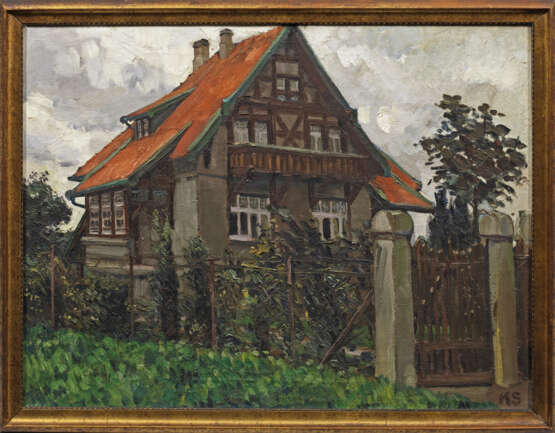ID 802364
Lot 1904 | Kurt Schwitters
Estimate value
€ 14 000 – 28 000
(1887 Hannover - 1948 Kendal/Cumbria/England)
Haus der Familie Wilke in Ricklingen
Mit schnellem, breitem, weich pastosem Pinselstrich ausgeführtes, noch ganz impressionistisches Frühwerk aus der Zeit um 1913. Schwitters studierte 1909 - 1914 an der Akademie der Künste in Dresden bei Carl Bantzer, Gottfried Kuehl und Emanuel Hegenbarth. Aus der Zeit vor seiner Hinwendung zum Dadaismus, Expressionismus, Futurismus und Kubismus in den Jahren ab 1917/18 ist nur eine relativ kleine Anzahl von Landschaften und Stillleben bekannt. 1918 lernte er Herwarth Walden kennen und hatte seine erste Ausstellung in dessen Galerie "Der Sturm" in Berlin. Schwitters schloss sich den Dadaisten an, wurde in Hannover Initiator einer Dada-Gruppe und arbeitete mit Hans Arp, Raoul Hausmann, Hannah Höch und Tristan Tzara zusammen. 1919 erfand Schwitters die revolutionäre "Merz"-Kunst und den zugehörigen Begriff "Merz", zunächst für seine Technik, aus Zeitungsausschnitten, Reklame und Fundstücken Collagen zu erstellen. Als Gegenprojekt zu einem eher destruktiven Dadaismus sollten diese Bilder und Skulpturen als Gesamtkunstwerk Leben und Kunst wieder vereinen. 1919 zeigte Schwitters sein erstes "MERZ-Bild" in der "Sturm"-Galerie, 1923 eröffnete er seine eigene "MERZ"-Schriftenreihe mit einer Dada-Nummer, dem "Holland Dada". Ab circa 1923 arbeitete Schwitters auch an seinem berühmten "Merzbau" (eine Collage-Raum-Skulptur) in seiner Wohnung im Haus der Eltern in Hannover (1943 bei einem Bombenangriff zerstört). Von den Nationalsozialisten als "entartet" verfemt, emigrierte Schwitters 1937 nach Norwegen und floh 1940 nach England. Öl/Lwd.; R. u. monogr.; 65 cm x 85 cm. Rahmen.
Wvz. Orchard/Schulz 77.
Provenienz: Anna Wilke, Ohlendorf (Nachlass); Leni Reuter, Ohlendorf (Nachlass); seitdem in Familienbesitz, Niedersachsen.
Oil on canvas. Monogrammed. Mentioned in the catalogue raisonné.
| Address of auction |
Kunstauktionshaus Schloss Ahlden GmbH Große Str. 1 29691 Ahlden(Aller) Germany | ||||||||||||||
|---|---|---|---|---|---|---|---|---|---|---|---|---|---|---|---|
| Preview |
| ||||||||||||||
| Phone | +49 5164 80100 | ||||||||||||||
| Buyer Premium | 25.0 | ||||||||||||||
| Conditions of purchase | Conditions of purchase | ||||||||||||||
| Business hours | Business hours
|



